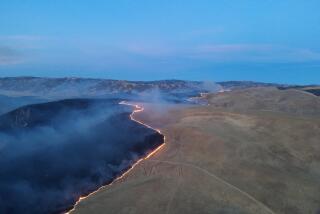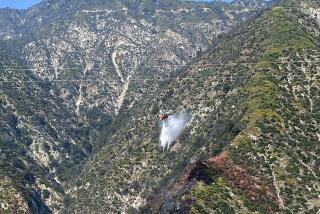‘Nuclear Winter’ Theory Put to Test in Burn Near L.A.
- Share via
Firefighters touched off a second brush fire Monday in the San Dimas forest that scientists hoped would enable them to test whether dense smoke from a nuclear war could enshroud the Earth and bring on a cataclysmic “nuclear winter.”
As researchers gathered data from positions on the ground and in specially equipped aircraft flying above, the blaze blackened an estimated 300 acres of the U.S. Forest Service’s San Dimas Experimental Forest in the San Gabriel Mountains about 25 miles northeast of downtown Los Angeles.
Monday’s fire was necessary because high humidity and moisture content in the brush hampered a similar experimental fire last December. Although Monday’s fire was about the same size as the one in December, the Forest Service said it may provide more data.
“It was dry up there this time. I think the fire burned faster and probably they got a better smoke plume this time than they did the last time,” Forest Service spokesman Rick Fletcher said.
Full results of research conducted during last winter’s burn will not be available for months, but Fletcher said some conclusions already have been drawn. For example, scientists discovered that air pollutants deposited on the chaparral over a period of decades are carried aloft during fires in concentrations 300 times higher than usually measured in the atmosphere.
While numerous scientific observations and experiments have been undertaken in the two fires, including measuring the fire’s impact on air quality and soil erosion, the nuclear winter experiment has generated the greatest public interest.
Blocking Out the Sun
Some scientists, including astronomer Carl Sagan, have hypothesized that a nuclear war would result in a massive cloud of smoke and ash from burning buildings, forests, and other combustible material that would block sunlight from large regions of the globe and precipitate a devastating “nuclear winter.”
It is theorized that in the drastically reduced temperatures, crops could not grow and humans who survived the nuclear exchange and subsequent radioactivity would be imperiled by climate changes. Others have said a nuclear cataclysm would more likely result in a warmer “nuclear autumn” than a nuclear winter.
Among those participating in the experiments are the U.S. Nuclear Defense Agency, which has equipped a plane to observe the fire, and the National Aeronautics and Space Administration, which has two planes. All together, between 50 and 75 scientists were involved in Monday’s $500,000 experiment. Last December’s project cost $750,000.
In addition to the Pentagon, NASA and the Forest Service, Fletcher said, other scientists joining in the experiment represented the U.S. Environmental Protection Agency, the state Air Resources Board and Department of Forestry, and the universities of Washington and California.
Many of the findings from the San Dimas fires will not be published in scientific journals for at least a year, Fletcher said.
Monday’s blaze comes at a time when more than 200 researchers and scientists from around the world are converging on Southern California to undertake an unrelated air quality study, and some of them expressed “mild concern” that the brush fire would interfere with their experiments.
However, officials of the South Coast Air Quality Management District, which issued the burn permit for Monday’s fire, and the state Air Resources Board said that the fire would have little or no impact on the $10-million Southern California air quality study.
“We would have preferred that this burn did not occur at all during the air study,” AQMD spokesman Ronald Ketcham said. However, he said, the fire comes during a lull in the study and could have only a “minimal” impact.
Aside from the fire’s scientific value, Fletcher said, it will enable the Forest Service to reduce the risk of summer fires.
More to Read
Sign up for Essential California
The most important California stories and recommendations in your inbox every morning.
You may occasionally receive promotional content from the Los Angeles Times.













